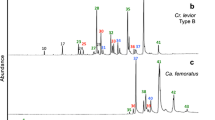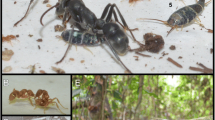Abstract
Workers of polydomous colonies of social insects must recognize not only colony-mates residing in the same nest but also those living in other nests. We investigated the impact of a decentralized colony structure on colony- and nestmate recognition in the polydomous Australian meat ant (Iridomyrmex purpureus). Field experiments showed that ants of colonies with many nests were less aggressive toward alien conspecifics than those of colonies with few nests. In addition, while meat ants were almost never aggressive toward nestmates, they were frequently aggressive when confronted with an individual from a different nest within the same colony. Our chemical analysis of the cuticular hydrocarbons of workers using a novel comprehensive two-dimensional gas chromatography technique that increases the number of quantifiable compounds revealed both colony- and nest-specific patterns. Combined, these data indicate an incomplete transfer of colony odor between the nests of polydomous meat ant colonies.



Similar content being viewed by others
References
Bourke AFG, Franks NR (1995) Social evolution in ants. Princeton Univ. Press, Princeton
Breed MD, Bennett B (1987) Kin recognition in highly eusocial insects. In: Fletcher DJC, Michener CD (ed) Kin recognition in animals. Wiley, Chichester, pp 243–285
Carlson DA, Bernier UR, Sutton BD (1998) Elution patterns from capillary GC for methyl-branched alkanes. J Chem Ecol 24:1845–1865
Crozier RH, Dix MW (1979) Analysis of two genetic models for the innate components of colony odor in social. Hymenoptera. Behav Ecol Sociobiol 4:217–224
Crozier RH, Pamilo P (1996) Evolution of social insect colonies. Oxford Univ. Press, Oxford
Dahbi A, Lenoir A (1998) Nest separation and the dynamics of the Gestalt odor in the polydomous ant Cataglyphis iberica (Hymenoptera, Formicidae). Behav Ecol Sociobiol 42:349–355
Debout G, Provost E, Renucci M, Tirard A, Schatz B, McKey D (2003) Colony structure in a plant-ant: behavioural, chemical and genetic study of polydomy in Cataulacus mckeyi (Myrmicinae). Oecologia 137:195–204
Dimandja J (2004) Comprehensive 2-D GC provides high-performance separations in terms of selectivity, sensitivity, speed and structure. Anal Chem 76:167A–174A
Errard C, Hefetz A, Jaisson P (2006) Social discrimination tuning in ants: template formation and chemical similarity. Behav Ecol Sociobiol 59:353–363
Ettershank G, Ettershank JA (1982) Ritualised fighting in the meat ant Iridomyrmex purpureus (Smith) (Hymenoptera: formicidae). J Aust Entomol Soc 21:97–102
Greaves T, Hughes RD (1974) The population biology of the meat ant. J Aust Entomol Soc 13:329–351
Keller L, Passera L (1989) Influence of the number of queens on nestmate recognition and attractiveness of queens to workers in the Argentine ant, Iridomyrmex humilis (Mayr). Anim Behav 37:733–740
Lahav S, Soroker V, Hefetz A, Vander Meer RK (1999) Direct behavioral evidence for hydrocarbons as ant recognition discriminators. Naturwissenschaften 86:246–249
Liu ZB, Bagneres AG, Yamane S, Wang QC, Kojima J (2001) Intra-colony, inter colony and seasonal variations of cuticular hydrocarbon profiles in Formica japonica (Hymenoptera, Formicidae). Insectes Soc 48:342–346
Nielsen J, Boomsma JJ, Oldham NJ, Petersen HC, Morgan ED (1999) Colony-level and season-specific variation in cuticular hydrocarbon profiles of individual workers in the ant Formica truncorum. Insect Soc 46:58–65
Nowbahari E, Lenoir A, Clément JL, Lange C, Bagneres AG, Joulie C (1990) Individual, geographical and experimental variation of cuticular hydrocarbons of the ant Cataglyphis cursor (Hymenoptera: formicidae): their use in nest and subspecies recognition. Biochem Syst Ecol 18:63–74
Reyment RA (1989) Compositional data analysis. Terra Rev 1:29–34
Rice WR (1989) Analyzing tables of statistical tests. Evolution 43:223–225
Rosengren R, Pamilo P (1983) The evolution of polygyny and polydomy in mound-building Formica ants. Acta Entomol Fenn 42:65–77
Silverman J, Liang D (2001) Colony disassociation following diet partitioning in a unicolonial ant. Naturwissenschaften 88:73–77
Thomas ML, Parry LJ, Allan RA, Elgar MA (1999) Geographic affinity, cuticular hydrocarbons and colony recognition in the Australian meat ant Iridomyrmex purpureus. Naturwissenschaften 86:87–92
van Wilgenburg E, van Lieshout L, Elgar MA (2005) Conflict resolution strategies in meat ants Iridomyrmex purpureus: ritualised displays versus lethal fighting. Behaviour 142:701–716
Vander Meer RK, Morel L (1998) Nestmate recognition in ants. In: Vander Meer RK et al (eds) Pheromone communication in social insects. Westview, Boulder, CO, pp 79–103
Wagner D, Tissot M, Cuevas W, Gordon DM (2000) Harvester ants utilize cuticular hydrocarbons in nestmate recognition. J Chem Ecol 26:2245–2257
Acknowledgements
This research was supported by an International Postgraduate Research Scholarship awarded by the Australian government, a Melbourne International Research Scholarship awarded by the University of Melbourne, the Holsworth Wildlife Research Fund, and the Joyce W. Vickery Scientific Research Fund of the Linnean Society of New South Wales. We would like to thank Ian and Linda Mclean for their generosity in permitting fieldwork on their property.
Author information
Authors and Affiliations
Corresponding author
Rights and permissions
About this article
Cite this article
van Wilgenburg, E., Ryan, D., Morrison, P. et al. Nest- and colony-mate recognition in polydomous colonies of meat ants (Iridomyrmex purpureus). Naturwissenschaften 93, 309–314 (2006). https://doi.org/10.1007/s00114-006-0109-y
Received:
Accepted:
Published:
Issue Date:
DOI: https://doi.org/10.1007/s00114-006-0109-y




